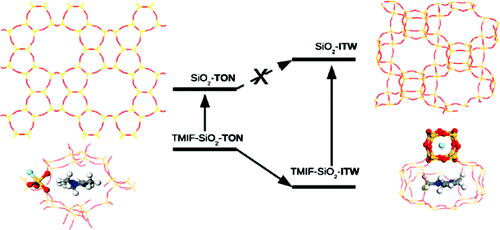当前位置:
X-MOL 学术
›
J. Am. Chem. Soc.
›
论文详情
Our official English website, www.x-mol.net, welcomes your
feedback! (Note: you will need to create a separate account there.)
In SituTransformation of TON Silica Zeolite into the Less Dense ITW: Structure-Direction Overcoming Framework Instability in the Synthesis of SiO2Zeolites
Journal of the American Chemical Society ( IF 14.4 ) Pub Date : 2010-03-17 , DOI: 10.1021/ja9094318 Claudio M. Zicovich-Wilson 1 , Felipe Gándara 1 , Angeles Monge 1 , Miguel A. Camblor 1
Journal of the American Chemical Society ( IF 14.4 ) Pub Date : 2010-03-17 , DOI: 10.1021/ja9094318 Claudio M. Zicovich-Wilson 1 , Felipe Gándara 1 , Angeles Monge 1 , Miguel A. Camblor 1
Affiliation

|
Under specific synthesis conditions the crystallization of a dense silica zeolite (TON) is followed by its in situ transformation into a less dense and, in the absence of occluded species, less stable zeolite (ITW). Periodic ab initio calculations including energy corrections for van der Waals interactions as well as zero-point and thermal effects are used first to assess the relative stability of both SiO(2) (calcined) phases and then to investigate host-guest interactions in the as-made zeolites, as well as their relative stability. The less dense SiO(2)-ITW is less stable than SiO(2)-TON, with an energy difference that is significantly larger than expected from their difference in molar volume. This extra destabilization is ascribed to the strained double 4-ring units of silica tetrahedra (D4R). Regarding the as-made materials, the organic cation fills in more efficiently the zeolitic voids in ITW than in TON, bringing about a larger stabilization in the former owing to the extension of the long-range addition of dispersion force contributions. On the other hand, fluoride induces a polarization of the silica framework that is highly localized in TON (showing pentacoordinated [SiO(4/2)F](-) units) but has a large global character in ITW (where fluoride is encapsulated into D4R units). We argue that the structure-directing role toward D4R materials that has been proposed for fluoride consists fundamentally in the ability to induce a global polarization of the silica framework that allows relaxation of the strain associated with these units. In this sense, fluoride stabilizes the otherwise strained D4R-SiO(2) frameworks making them reachable for crystallization. This work documents a case in which the structure directing agents "choose" a structure not kinetically but through stabilization.
中文翻译:

TON 二氧化硅沸石原位转化成密度较低的 ITW:克服结构方向在 SiO2 沸石合成中的骨架不稳定性
在特定的合成条件下,致密的二氧化硅沸石 (TON) 结晶后,会原位转化为密度较低且在不存在吸留物质的情况下稳定性较差的沸石 (ITW)。包括范德华相互作用能量校正以及零点和热效应在内的周期性从头计算首先用于评估 SiO(2)(煅烧)相的相对稳定性,然后研究作为-制成的沸石,以及它们的相对稳定性。密度较低的 SiO(2)-ITW 不如 SiO(2)-TON 稳定,能量差异明显大于它们摩尔体积差异的预期。这种额外的不稳定归因于二氧化硅四面体 (D4R) 的应变双 4 环单元。关于制作的材料,有机阳离子在 ITW 中比在 TON 中更有效地填充沸石空隙,由于分散力贡献的长程添加的扩展,在前者中带来更大的稳定性。另一方面,氟化物引起二氧化硅骨架的极化,该极化在 TON 中高度局部化(显示五配位 [SiO(4/2)F](-) 单元)但在 ITW 中具有较大的全局特征(其中氟化物被封装到D4R 单位)。我们认为,针对氟化物提出的 D4R 材料的结构导向作用基本上在于能够诱导二氧化硅框架的全局极化,从而可以松弛与这些单元相关的应变。从这个意义上说,氟化物稳定了原本紧张的 D4R-SiO(2) 框架,使它们可以结晶。
更新日期:2010-03-17
中文翻译:

TON 二氧化硅沸石原位转化成密度较低的 ITW:克服结构方向在 SiO2 沸石合成中的骨架不稳定性
在特定的合成条件下,致密的二氧化硅沸石 (TON) 结晶后,会原位转化为密度较低且在不存在吸留物质的情况下稳定性较差的沸石 (ITW)。包括范德华相互作用能量校正以及零点和热效应在内的周期性从头计算首先用于评估 SiO(2)(煅烧)相的相对稳定性,然后研究作为-制成的沸石,以及它们的相对稳定性。密度较低的 SiO(2)-ITW 不如 SiO(2)-TON 稳定,能量差异明显大于它们摩尔体积差异的预期。这种额外的不稳定归因于二氧化硅四面体 (D4R) 的应变双 4 环单元。关于制作的材料,有机阳离子在 ITW 中比在 TON 中更有效地填充沸石空隙,由于分散力贡献的长程添加的扩展,在前者中带来更大的稳定性。另一方面,氟化物引起二氧化硅骨架的极化,该极化在 TON 中高度局部化(显示五配位 [SiO(4/2)F](-) 单元)但在 ITW 中具有较大的全局特征(其中氟化物被封装到D4R 单位)。我们认为,针对氟化物提出的 D4R 材料的结构导向作用基本上在于能够诱导二氧化硅框架的全局极化,从而可以松弛与这些单元相关的应变。从这个意义上说,氟化物稳定了原本紧张的 D4R-SiO(2) 框架,使它们可以结晶。


















































 京公网安备 11010802027423号
京公网安备 11010802027423号